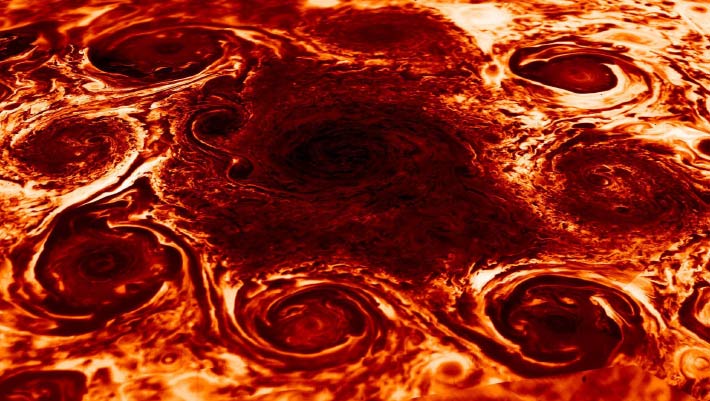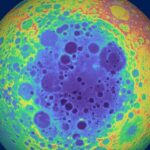Planetary scientists first made the connection between Earth and Jupiter in 2018 when they noticed a striking similarity between images of Jupiter’s huge cyclones and the ocean turbulence. In 2022, they analyzed high-resolution infrared images of Jupiter’s cyclones taken by NASA’s Juno spacecraft. The analysis revealed that a type of convection similar to what is seen on Earth helps maintain Jupiter’s storms, which can be thousands of miles wide and last for years. The 2022 study focused directly on Jupiter’s cyclones, but the authors also saw wispy tendrils, known as filaments, in the spaces between the gassy vortices. These filaments also had earthly analogs, and they used Juno’s detailed imagery to study whether this similarity to our planet’s oceanic and atmospheric processes was merely skin deep.
This composite image, derived from data collected by the JIRAM instrument aboard NASA’s Juno orbiter, shows the central cyclone at Jupiter’s north pole and the eight cyclones that encircle it. JIRAM collects data in infrared, and the colors in this composite represent radiant heat: the yellow (thinner) clouds are about 9 degrees Fahrenheit (minus 13 degrees Celsius) in brightness temperature and the dark red (thickest) are around minus 181 degrees Fahrenheit (83 degrees Celsius). Image credit: NASA / JPL-Caltech / SwRI / ASI / INAF / JIRAM.
Fronts are often discussed in weather forecasts — cold fronts or storm fronts, for example — but they apply to both gases and liquids.
A front is the boundary between gas or liquid masses with different densities due to differences in properties like temperature.
In the ocean, fronts can also be due to differences in salinity, which influences the density of seawater along with temperature.
A key feature of fronts is that their leading edges feature strong vertical velocities that can create winds or currents.
To try to understand the role of the filaments she could clearly see in between the cyclones on Jupiter in Juno’s images, Dr. Lia Siegelman from the Scripps Institution of Oceanography and Caltech’s Dr. Patrice Klein looked at a series of infrared images from Juno.
The batch of images were of Jupiter’s north polar region and were taken in 30-second increments.
The fact that the images were in infrared the team to calculate temperature — bright areas were warmer and dark areas were cooler.
On Jupiter, the hotter parts of the atmosphere correspond to thin clouds and the colder parts represent thick cloud cover, blocking more of the heat emanating from Jupiter’s super-heated core.
The researchers then tracked the movement of clouds and filaments across the 30 second intervals separating the photographs to calculate horizontal wind speeds.
These two pieces of information allowed the scientists to apply methods from ocean and atmospheric science to Jupiter, allowing them to calculate the vertical wind speeds that would correspond to the temperatures and horizontal wind speeds the researchers derived from the images.
Once they calculated the vertical wind speeds, they were able to see that Jupiter’s filaments were indeed behaving like fronts on Earth.
Those vertical wind speeds at the edges of fronts on Jupiter also meant that the fronts were involved in transporting energy in the form of heat from the planet’s hot interior to its upper atmosphere — fueling the giant cyclones.
Though convection is the main driver, the fronts account for a quarter of the total kinetic energy powering Jupiter’s cyclones and forty percent of the vertical heat transport.
“These cyclones on Jupiter’s poles have persisted since they were first observed in 2016,” Dr. Siegelman said.
“These filaments in between the large vortices are relatively small but they are an important mechanism for sustaining the cyclones.”
“It’s fascinating that fronts and convection are present and influential on Earth and Jupiter — it suggests that these processes may also be present on other turbulent fluid bodies in the Universe.”
“Jupiter’s massive scale and Juno’s high-resolution imagery can allow for a clearer visualization of the ways in which smaller-scale phenomena like fronts connect to larger ones like cyclones and the atmosphere at large — connections that are often hard to observe on Earth where they are much smaller and more ephemeral.”
“However, a long-awaited new satellite known as SWOT is poised to make these kinds of ocean phenomena vastly easier to observe.”
“There is some cosmic beauty in finding out that these physical mechanisms on Earth exist on other far-away planets.”
The team’s paper was published in the journal Nature Physics.
_____
L. Siegelman & P. Klein. Frontogenesis at Jovian high latitudes. Nat. Phys, published online June 6, 2024; doi: 10.1038/s41567-024-02516-x




